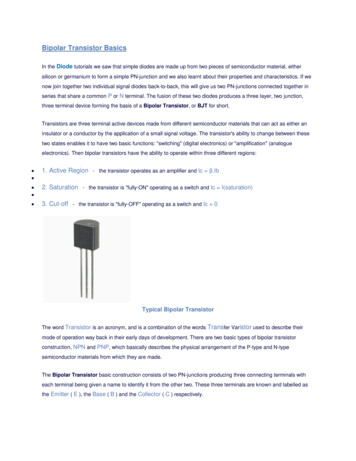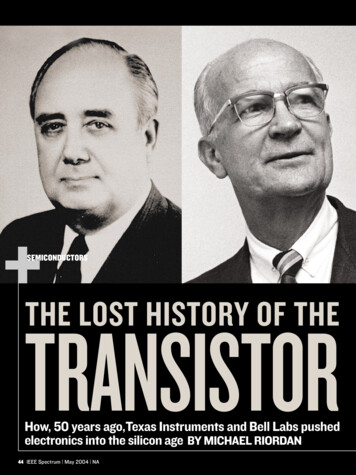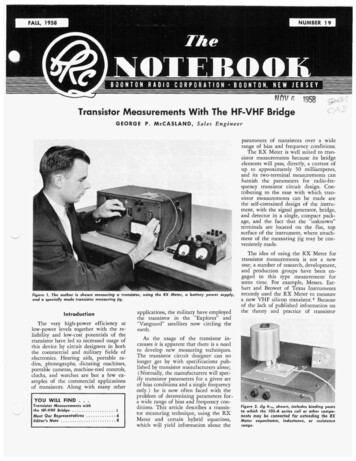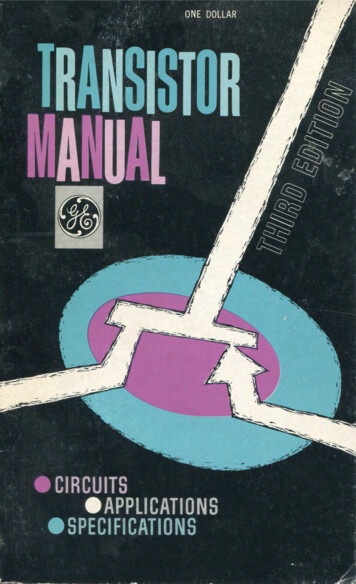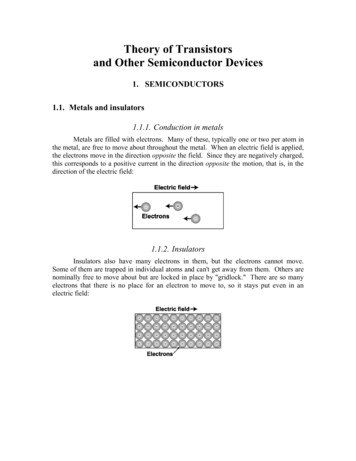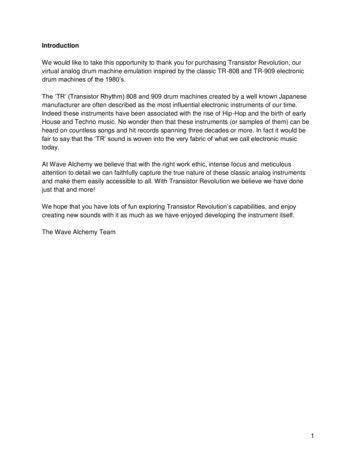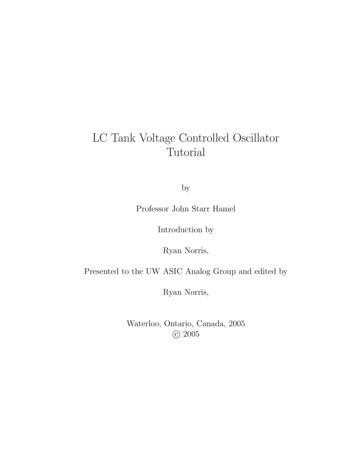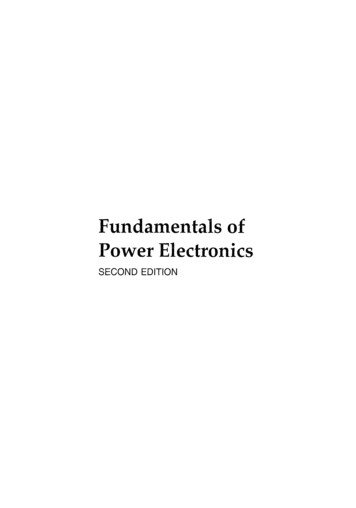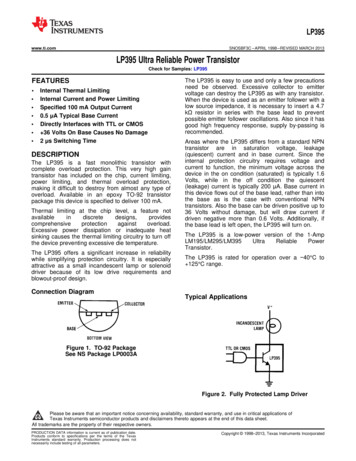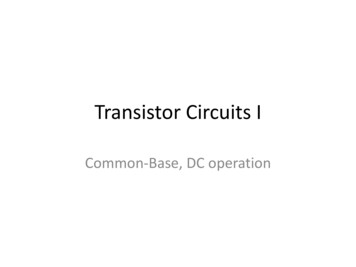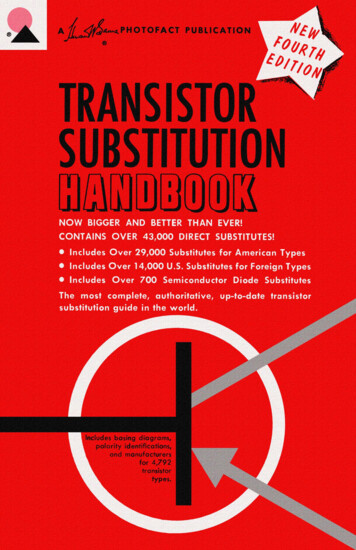
Transcription
1.50Cat. No. SSH-4µ&TRANSISTORSUBSTITUTIONHANDBOOKbyThe Howard W. Sams Engineering StaffHOWARD W. SAMS & CO., INC.THE BOBBS-MERRILL COMPANY, INC.Indianapolis New York
FIRST EDITIONFIRST PRINTING - MARCH, 1961SECOND PRINTING - MARCH, 1961THIRD PRINTING - APRIL, 1961FOURTH PRINTING - JUNE, 1961FIFTH PRINTING-AUGUST, 1961SECOND EDITIONFIRST PRINTING - OCTOBER, 1961SECOND PRINTING - DECEMBER, 1961THIRD EDITIONFIRST PRINTING - APRIL, 1962FOURTH EDITIONFIRST PRINTING - JANUARY, 1963TRANSISTOR SUBSTITUTION HANDBOOKCopyright 1961, 1962, and 1963 by Howard W. Sams & Co.,Inc., Indianapolis 6, Indiana. Printed in the United States ofAmerica.Reproduction or use, without express permission, of editorialor pictorial content, in any manner, is prohibited. No patentliability is assumed with respect to the use of the informationcontained herein. While every precaution has been taken inthe preparation of this book, the publisher assumes no responsibility for errors or omissions. Neither is any liabilityassumed for damages resulting from use of the informationcontained herein.Library of Congress Catalog Card Number: 61-10965
TABLE OF CONTENTSIntroduction4A Guide to Making Transistor Substitutions6SECTION 1American Transistor Substitution Guide8Low-Power Types10High-Power Types65SECTION 2American Substitutes for Foreign Transistors93Low-Power Types95High-Power Types. 128SECTION 3Crystal Diode Substitution Guide. 136Basing Diagrams . 141
INTRODUCTIONSince the development of the transistor, thousands of differenttypes have been produced. Considering the multitude of applications they are finding in today's electronic equipment, it is reasonable to assume that newer types will continue to be introducedat an even faster pace.This rapid development, however, does leave some problems inits wake. The design engineer and prototype technician are facedwith such wide choices of transistor types that they often end updesigning circuits to fit transistors, rather than vice versa. Andwhen it becomes necessary to make replacements, the servicetechnician has his problems, too. For example, the original typemay no longer be manufactured-or it may not be readily available, which means the repair cannot be completed unless a suitable substitute can be found.Paradoxically, the same conditions which lead to the limitlessvariations in transistors also make substitutions quite feasible.To understand this in detail, you have to know how transistorsare made. Suffice it to say, for the sake of brevity, that transistorsare type-numbered after they are manufactured-not before, aswith tubes. Furthermore, in trying to produce a specific type,the manufacturer often produces many by-product types withcharacteristics somewhat beyond the specification limits. Theseare classified according to their characteristics, and assigned typenumbers for identification.Transistors are not classified in the same manner as tubes,simply because the specifications for one manufacturer's productsare often not exactly the same as another's. Yet, after all specifications are scrutinized, we find that they may be almost the sameas for some previously-introduced types. In addition, there is a"family resemblance" between the types developed as by-products.If you examine the specifications for the 2N513, 2N513A, 2N514,2N514A, and 2N514B, for example, you'll find many of the characteristics are exactly the same, and that there are only slightdifferences in a few of the specifications.4
What does all this mean? Simply that transistors "in the samefamily" can often be substituted for one another. Notice the wordoften, however. First of all, transistors "in the same family" donot necessarily have sequential type numbers; there are manyinstances where transistors bearing sequential numbers are asdifferent from one another as black from white. Secondly, thedesign parameters of some circuits will be exceeded by some orall transistors of similar types; thus, use of a substitute may resultin improper circuit operation. On the other hand, numerous experiments indicate that less critical transistor circuits will operate-with varying degrees of efficiency-using practically any transistor having the proper polarity (NPN or PNP).It is with these thoughts in mind that we bring you this newedition of Transistor Substitution Handbook. To assure you ofthe most accurate substitutions possible, the substitutions in thisfourth issue have been selected by the use of an IBM 1401 computer. The computer, supplied with exact transistor parameters,automatically and unerringly chose those substitutions foundherein.December, 1962s
A GUIDE TO MAKING TRANSISTOR SUBSTITUTIONSBasically, there are only two reasons for considering the use ofa substitute transistor-(!) when the original type is no longerbeing manufactured, and (2) when the exact type cannot be obtained without a costly delay. In the first instance, there is obviously no choice; either a suitable substitute must be found or theequipment in which it is used must be modified or discarded. Inthe second instance, there are two choices: If the design parameters of the circuit are extremely critical, it is advisable to orderan exact replacement. However, if an immediate repair is necessary, a substitute transistor may be tried in the meantime, withthe hope that a temporary repair can be effected until the propertype is obtained.Generally speaking, similar-type transistors designed for use inmedium- and low-frequency circuits can be readily substituted foreach other, particularly if the requirements of the equipment arenot too exacting. (Radios, audio amplifiers, and other such homeentertainment devices are good examples.) For these applications,only a few transistor characteristics need be considered in selecting a substitute. First of all, of course, is polarity. An NPN typecan never be directly substituted for a PNP type, and vice versa.Another major consideration is the maximum collector-currentrating. Obviously, a transistor capable of handling a maximumcurrent of 50 ma, used in a circuit which results in conduction of100 ma or more, can lead to disaster. Maximum collector dissipation is another important characteristic. Primarily, it is a functionof junction temperature (which can change with the ambienttemperature), heat-sink efficiency, and thermal resistivity. If asubstitute transistor has a higher thermal resistivity than the unitit replaces, the dissipation rating may have to be greater in orderto safely handle the same collector current. Since the transistor isa completely thermal-dependent device, it is most important torealize that even though a given substitution may work at roomtemperature, there is no assurance that "runaway" will not takeplace if there is high dissipation, or a high ambient condition.6
Biasing circuits are designed to provide thermal stability. Theyare based on the gain, leakage currents, and thermal characteristics of the particular transistor they are used with. When youinstall a substitute, you may upset the thermal stability of the circuit if you use a transistor with higher Beta (in a grounded collector, for instance). Even if the leakage currents are exactly thesame, more current will flow in the collector circuit. This willcause additional heat to be dissipated, which in turn causes leakage current to increase. Thus, the gain figure should be about thesame, or lower, if thermal runaway is to be avoided.Some final points to consider in selecting suitable transistor substitutes have to do with physical design. In this respect, transistorsdiffer in semiconductor materials, structure, basing, size, andshape. Although two transistors may be electrically similar, theymay be quite different physically. Thus, if the allotted space for atransistor is limited, size and shape must also be considered. Thechoice of a substitute may be further limited by the mountingfacilities, requiring that the basing characteristics be the same as,or similar to, the original. The semiconductor material and thestructure of the transistor (grown, diffused, junction, etc.) affectthe electrical more than the physical characteristics. Furthermore,they are relatively unimportant unless a substitute with exactingspecifications must be selected. It stands to reason that units whichare similar both electrically and physically are more alike thanthose which are similar in only their electrical specifications. Consequently, when you are confronted with the problem of selecting a substitute transistor with exacting specifications, it is advisable to consult a manual which lists all the characteristics beforemaking a final decision.7
SECTION lMASTER TRANSISTOR SUBSTITUTION GUIDEThis section, containing only transistors manufactured in America, is broken down into two groups of transistors-low powerand high power, respectively. (Foreign transistors are listed inSection 2.) The left-hand column, under the heading To Replace,is arranged alpha-numerically. Suitable substitutes are shown inthe extreme right-hand column. The second column lists thepolarity (P for PNP and N for NPN), and the diagram numberwhich refers to the basing arrangement of the original type (seetable of contents for the location of the basing diagrams). Thethird column lists the manufacturers who supply the originalunit. The key to manufacturers appears on Page 9.The substitutes shown do not necessarily have the same physical characteristics as the original types. To determine the basingfor a substitute, simply locate its number in the first column. Forcharacteristics other than those shown, refer to suitable transistorspecification data.8
KEY TO MANUFACTURERSADV-Advanced Research AssociatesAMC-Amelco Inc.AME-Advanced Micro-Electronics Inc.AMP-Amperex Electronic Co.BEN-Bendix Semiconductor ProductsBOG-Bogue Electric Mfg. Co.CBS-CBS ElectronicsCDC-Continental Device Corp.CPC-C. P. Clare Transistor Corp.CRY-Crysta IonicsCSC-Clark Semiconductor Co.CTP-Clevite Transistor Corp.DEL-Delco Radio Div., General Motors Corp.EMC-Electromation Co.EMR-Emerson Radio & Phonograph Corp.ETC-Electronic Transistors Corp.FSC-Fairchild Semiconductor Corp.FTC-Fanon Transistor Corp.GE-General Electric Co.GIC-General Instrument Corp.GPC-Germanium Products Co.GTC-General Transistor Corp.HSD-Hoffman Semiconductor Div.HUG-Hughes ProductsITC-lndustro Transistor Corp.KSC-Kearfott Semiconductor Corp.MAL-P. R. Mallory & Co., Inc.MH-Minneapolis-Honeywell SemiconductorProductsMOT-Motorola Semiconductor ProductsNA-National AircraftNAS-National Semiconductor Corp.NU-National UnionPHL-Philco Corp.PSI-Pacific Semiconductor, Inc.RAY-Raytheon Semiconductor Div.RCA-Radio Corporation of AmericaRDR-Radio Development & ResearchRHE-Rheem Semiconductor Corp.SEC-Secoa Electronics Corp.SEM-Semitronics Corp.Sil-Silicon Transistor Corp.SOI-Semi-Onics Inc.SPR-Sprague Electric Co.SSD-Sperry Semiconductor Div.SSP-Solid-State ProductsSYL-Sylvania Semiconductor Div.TEC-Transitron Electric Corp.TH-Texas InstrumentsTS-Tung-Sol Electric Semiconductor Div.UST-U.S. Transistor Corp.WEC-Western Electric Co.WES-Westinghouse Electric Corp.WTC-Western Transistor Corp.WTV-Workman TVZEN-Zenith Radio Corp.9
LOW-POWER TYPESTo ReplaceType,Dia. TC,GE,UST2N59P58 ETC2N59AP58 ETC,WES2N59BP58 ETC,WES2N59C2N60P58 ETC,WESP58 ETC,WESZN60AP58 Nl076,2Nl077 ,2Nl 1732N43,2N43A,2N . 4,2Nl05,2rU08 A,2Nll3,2Nll4,2Nl30A2N"" 0BP58 ETC,WES2N60C2N6lP58 ETC,WESP58 ETC,WES2N61AP58ZN618P58 ETC,WESZN61C2N63P58 ETC,WESP5 2N98NETC,RDR2N99NETC,RDR2Nl0l/l32Nl03P64 A,2N413,ZN414,ZN4148
To ReplaceType,Dia. STEC,TI I2Nll8NSTEC,TI I2Nll8AN5TEC,TI I2Nll9NSTEC,TI I2Nl20N5TEC ,TI I2Nl23P9ETC,ITC,GE2Nl23/5P58 SYL2Nl24N4ETC2Nl2SN5ETCETC2Nl26NS2Nl28P6S CBS,PHL,SPR2Nl29P6S ApETC,RAY2Nl35P59 ETC,FTH,GE2Nl36P59 ETC,FTH,GE2Nl37P59 te2N597,2N943,2N944,2N945 1 2N790,11
To E,ETCETC,GEGE l94AN5ETC,SYL2N207P6S ETC,PHL2N207AP6S ETC,PHL2N207BP6S 2N394A,2N396A,2N413,2N413A,2N4142N43 ,2N44,2N59, 2N59.A, 2N59B ,2N60, 2N60A,2N60B,2N61,2N61A2N43 ,2N38SA,2N388A,2N576A,2Nl605A
To ReplaceType,Dia. Mfr.2N213AN2N2142N215N5 ETC,SYLPl6 ATL,ETC,RCAETC,SYL2N216N52N217Pl6 ETC,RCA,SYL2N2182N219Pl6 ATL,ETC,RCA,SYLPl6 ETC,RCA2N220Pl6 ETC,RCA2N223P49 ETC,PHL2N224P49 ETC,PHL2N226P49 32P65 CBSP65 CBS,PHL2N233NETC,SYL2N233AN5ETC ,SYL2N2372N238pETC ,NAETC,TII2N240P65 CBS,PHL,SPR2N241P9P5ETC ,GE2N241AP9ETC,GE2N243N5NA,TI I2N244N5NA,T! I2N247pSYL2N248P5T 112N249pETC,T I 71ApETC,RAY2N2742N279Pl6 ATL,ETC,RCApAMP ,ASC, ETC,MULpAMP,ASC,ETC,MULP58 383,2N524,2N524A,2N525,13
To ReplaceType,Dia. Mfr.MUL2N283pAMP ,ASC 25,2N525A,2N526,2N526A2Nl008B,2Nl924 A,2NS04,2N591,2N591/5,2N311P58 ETC,GIC,GTC,2N312N58 94AN5ETC,SYL2N972N315NETC,RDR2N315AP58 ETC,GIC,GTC,2N315BP58 ETC,GIC2N316P58 ETC,GIC,GTC,2N316AP58 ETC,GIC,GTC,2N317P58 ETC,GIC,GTC,2N317AP58 ETC,GIC,GTC,2N319P58 MOTP58 582N322P582N323P582N324P582N327AP58GE, ITC GE, ITC FTH,GE,ITC,MOT,SEC,SYL,USTCDL,ETC,FTH,GE, ITC ,MOT,SECCRY,GIC,HUG,KSC,NAS,RAY,SSD,Tll,WTCKSC ,RAY, Tl I2N328p2N328AP58 5301,ACZ10,BCZ12,0C449K,
To 42N334AType,Dia. Mfr.KSC,NAS,RAY,SSD,T!J,WTCP58 CRY,GIC,HUG,KSC,NAS,RAY,SSD, Tl I ,WTCP4 KSC,SSO,TllBEN,ETC,GIC,ITC,KCS MOT RCA,USTN58 AMP,GE,NAS,RAY,RDR,TEC,Tll,TIBN58 GE ,NAS, T IIP4N58 AMP,GE,NAS,RAY,RDR,TEC,Tll,TIBN58N58 AMP,GE,NAS,RAY,ROR,TEC,Tl I,TIBN58 GE,NAS,TII2N335AN58 AMP,GE,NAS,PSl,RAY,RDR,TEC,TI I ,TIBN58 GE,NAS2N335BN2N336N58 AMP,GE,NAS,RAY,TEC,T 11N58 GE,NAS,TII2N3352N336AGE,NAS2N339N58 AMP ,FTH,GE,NAS,RAY,ROR,TEC,T!J,TIBN58 GEN58 GEN58 AMP ,FTH,GE,NAS,RAY,SEC,TEC,T! I ,TIBN58 NAS,TEC,TII2N339AN58 TEC2N3402N340AN58 NAS,TEC,TIIN58 TEC2N3412N341A2N342N58 NAS,TEC,TIIN58 TECN58 NAS,TEC,T!I2N342A2N343N58 TE'.C ,T 11N58 NAS,TEC,TII2N344P65 CBS,PHL,SPR2N345P65 CBS,PHL,SPR2N3"6P65 CBS,PHL,SPR2N347N2N3482N3492N356N RDRNRDRN58 CBS,ETC,GIC,GTC,SYL,TADN58 CBS,ETC,GIC,GTC,SYL,TADN58 CBS,ETC 7M2N341,2N342A,COQ10012,CD010013,COQlO N620,2N621,2NlO O,2Nl012,2Nl074,2Nl075,2Nl0762N356,2N35815
To N364Type,Dia.Mfr.GTC,SYL,TADN58 CBS,ETC,GIC,GTC,SYL,TADN58N58 CBS,ETC,GfC,GTC,SYL,TADP58 ENB,ETC, ITC,RAY,USTP58 ENB,ETC,ITC,RAY,USTP58 ENB,ETC,ITC,RAY,USTP58 ENB ,ETC, I TC,RAY,USTP58 ENB,ETC,ITC,RAY,USTN5 P5ETC,TII2N369P5ETC ,T 112N370P7RCA ,SYL2N37Q/33Pl7 SYL2N37lP72N37l/33Pl7 SYLRCA,SYL2Nl72P72N372/33Pl7 SYL2N373P7RCA,SYL2N374P7RCA,SYL2N377N58 CBS,CSF,ETC,2N377AN58 8 ETC,KSC,SYL,TS,USTP58 ETC,SYL,TS,US2N383P58 ETC,SYL,TS,US2N3812N384Pl6 ATL,CSF,MIS,RCA2N384/33Pl7 SYL21'1385N58 CBS,ETC,GE,2N385AN58 2N394P5816SYL,TADCBS,ETC,FTH,GE,MIS,RAY,Tl ICBS,ETC,RAY,RCA,SYL,TAD,T ,ACl06,SFT28 384,2 : } !;! f i! :; SF
Sil-Silicon Transistor Corp. SOI-Semi-Onics Inc. SPR-Sprague Electric Co. SSD-Sperry Semiconductor Div. SSP-Solid-State Products SYL-Sylvania Semiconductor Div. TEC-Transitron Electric Corp. TH-Texas Instruments TS-Tung-Sol Electric Semiconductor Div. UST-U.S. Transistor Corp. WEC-Western Electric Co. WES-Westinghouse Electric Corp.

